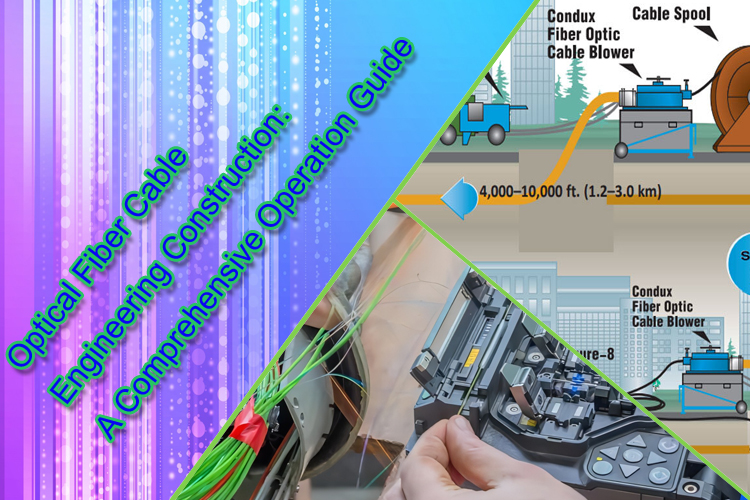By goodvin | 30 May 2023 | 0 Comments
Optical Fiber Cable Engineering Construction: A Comprehensive Operation Guide
Optical Fiber Cable Engineering Construction: A Comprehensive Operation Guide
1. Introduction
Optical Fiber Cable engineering construction refers to the process of designing, planning, executing, and maintaining communication system infrastructure by deploying optical cables and associated components. These systems are critical to ensuring robust and high-speed communication networks.
This operation guide is designed to provide detailed and highly instructive information on the optical Fiber cable engineering construction process. By following this guide, engineering professionals will ensure that they develop a high-quality, reliable communication network that meets industry standards and future requirements.
Keywords: Optical Fiber Cable, Engineering Construction, Communication Network, Fiber Optic, Infrastructure

2. Project Planning
Successful Optical Fiber Cable construction projects begin with thorough planning. Key factors to consider during project planning include:
1. Determining the network’s purpose and target performance
2. Selecting the appropriate optical cable types, such as Single Mode Fiber (SMF) or Multi-Mode Fiber (MMF)
3. Evaluating the system’s compatibility with existing infrastructure and equipment
4. Establishing the route for the cable deployment
5. Identifying necessary permits and regulatory requirements
6. Estimating cost and allocating resources
7. Developing a project schedule with project milestones and completion dates
3. Optical Fiber Cable Selection and Procurement
With a clear understanding of the network’s requirements, engineers can select the appropriate optical cable type and procure necessary materials. Considerations for selecting optical cables include:
1. Transmission distance: SMF is suitable for long-distance transmissions, while MMF is ideal for short distances
2. Data rates and bandwidth: Choose cables that support the desired data rates and bandwidth
3. Compatibility with existing equipment: The types of connectors and adapters must align with installation requirements
4. Optical Fiber Cable Installation
Optical Fiber Cable installation processes vary depending on local conditions, route complexity, and regulatory requirements. The following general steps outline the installation process:
1. Site Preparation: Clear the installation route and mark any obstacles or hazards, such as underground utilities or environmental concerns
2. Trenching: Excavate trenches, lay conduit (if necessary), and install dense aggregate to assist with cable placement and protection
3. Cable Laying: Deploy optical cables in the trenches or aerial path, while ensuring adherence to cable tension and bending radius guidelines to avoid cable damage
4. Splicing: Perform splicing to connect sections of the optical cable, either by using fusion splicing or mechanical splicing methods
5. Testing: Test the installed system to ensure signal transmission quality and loss are within acceptable limits
5. Network Termination
Network termination is essential for connecting the Optical Fiber Cable infrastructure to both the transmitter and receiver equipment. The process usually involves:
1. Installing the optical cable’s end-point connectors, such as SC, LC, or FC types
2. Connecting the optical cable to equipment like Optical Network Units (ONUs) or Optical Line Terminals (OLTs), which facilitate signal transmission and reception
3. Ensuring proper cable and connector cleanliness to avoid signal degradation
6. Network Documentation and Maintenance
Comprehensive documentation and maintenance are crucial for maintaining a high-performing Optical Fiber Cable network. Key practices include:
1. Documenting network configurations, including cable routes, splice points, and equipment installation details
2. Establishing a maintenance schedule that includes routine inspections, equipment upgrades, and cleaning procedures
3. Developing a well-organized fault detection and resolution system for addressing any network issues promptly and efficiently
7. Conclusion
Optical Fiber Cable engineering construction is a complex process requiring expertise in both project management and technical installation practices. By following the detailed steps outlined in this operation guide, engineering professionals can ensure high-quality communication network infrastructure that meets performance and regulatory requirements. Additionally, proper documentation and maintenance practices will ensure the longevity and reliability of the Optical Fiber Cable systems.
Leave a Reply
Your email address will not be published.Required fields are marked. *
POPULAR BLOG
- Will SDM Technology Become the Only Way for High-Capacity Optical Transmission?
- Fiber Optic Network Development Strategy and Technical Roadmap
- Impact of Technical Innovation of Optical WDM on the Future of Optical Communication
- ATB Subscriber Terminal Box: Enhancing Connectivity in Telecommunication Networks
- Comparison and Analysis of CWDM and DWDM in Multi-view